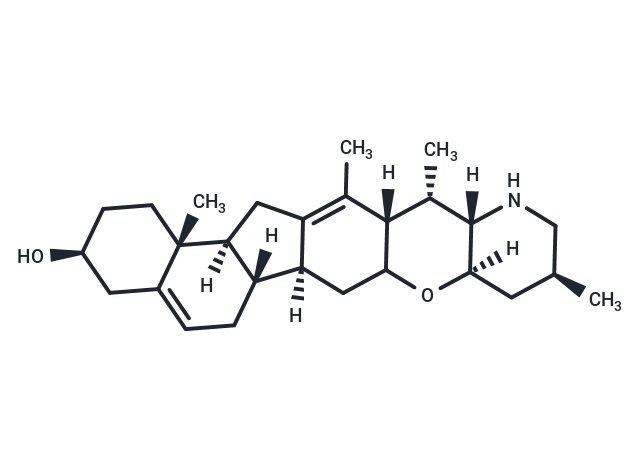Shopping Cart
- Remove All

Your shopping cart is currently empty


| Pack Size | Price | Availability | Quantity |
|---|---|---|---|
| 5 mg | $48 | In Stock | |
| 10 mg | $74 | In Stock | |
| 25 mg | $136 | In Stock | |
| 50 mg | $224 | In Stock | |
| 100 mg | $357 | In Stock | |
| 1 mL x 10 mM (in DMSO) | $54 | In Stock |
| Description | Cyclopamine (11-Deoxojervine), a Smoothened (Smo) antagonist (IC50: 46 nM in TM3Hh12 cells), belongs to the group of steroidal jerveratrum alkaloids. |
| Targets&IC50 | Smo:46 nM (TM3Hh12 cells) |
| In vitro | The Chicken embryos Exposure to cyclopamine resulted in visible external defects, including cyclopia, microphthalmia, proboscis formation, amelia, thoracic lordosis, and decreased body size [2]. cyclopamine treatment reduced the growth of tumor cell lines from the oesophagus, stomach, biliary tract and pancreas by 75–95% compared with tomatidine controls [3]. In pancreatic cancer cell lines, Hh inhibition with cyclopamine resulted in down-regulation of snail and up-regulation of E-cadherin, consistent with inhibition of epithelial-to-mesenchymal transition, and was mirrored by a striking reduction of in vitro invasive capacity (P < 0.0001) [4]. |
| In vivo | To examine the effects of cyclopamine treatment in vivo, subcutaneous xenografts from HUCCT1 cells, a metastatic cholangiocarcinoma cell line, were established in athymic mice. Tumours in cyclopamine-treated animals regressed completely by 12 days [3]. In the delayed treatment model, no difference in weight was noted between control and cyclopamine (1.2 mg) treated BxPC3-SMOlow tumours. By contrast, a 50–60% decrease in tumour mass was observed in Panc 05.04- and L3.6sl-derived tumours, respectively (Fig. 5b, c)—an even more marked effect was noted in the concurrent treatment model, which revealed an 84% reduction in tumour mass of L3.6sl-derived tumours [5]. |
| Kinase Assay | This assay measures the end stage of the Hh signaling pathway, that is, the transcriptional modulation of Gli, using Luciferase as readout (Gli-Luc assay). Cyclopamine is prepared for assay by serial dilution in DMSO and then added to empty assay plates. TM3Hh12 cells (TM3 cells containing Hh-responsive reporter gene construct pTA-8xGli-Luc) are resuspended in F12 Ham's/DMEM (1:1) containing 5% FBS and 15 mM Hepes pH 7.3, added to assay plates and incubated with Cyclopamine for approximately 30 minutes at 37 °C in 5% CO2. 1 nM Hh-Ag 1.5 is then added to assay plates and incubated at 37 °C in the presence of 5% CO2. After 48 hours, either Bright-Glo or MTS reagent is added to the assay plates and luminescence or absorbance at 492 nm is determined. IC50 value, defined as the inflection point of the logistic curve, is determined by non-linear regression of the Gli-driven luciferase luminescence or absorbance signal from MTS assay vs log10 (concentration) of Cyclopamine using the R statistical software pack [1]. |
| Cell Research | Cells were cultured in triplicate in 96-well plates in assay media to which 5E1 monoclonal antibody, ShhNp and/or cyclopamine were added at 0 h at concentrations indicated in the main text. Viable cell mass was determined by optical density measurements at 490 nm (OD490) at 2 and 4 days using the CellTiter96 colorimetric assay. Relative growth was calculated as OD (day 4) 2 OD (day 2)/OD (day 2) [3]. |
| Animal Research | A total of 0.1 ml Hanks' balanced salt solution and matrigel (1:1) containing 2 × 10^6 cells were injected subcutaneously into CD-1 nude mice. Tumours were grown for 4 days to a minimum volume of 125 mm3; treatment was initiated simultaneously for all subjects. Mice were injected subcutaneously with vector alone (triolein:ethanol 4:1 v/v) or a cyclopamine suspension (1.2 mg per mouse in triolein: ethanol 4:1 v/v) daily for 7 days. At the end of the treatment period, tumours were excised from mice, weighed and then fixed for 3 h at 4 °C with 4% paraformaldehyde, embedded in paraffin wax and sectioned (6 μm). Apoptotic cells were identified by TUNEL using recombinant Tdt as previously described29. Sections were then counterstained with eosin. Eight ×20-magnified fields from regions corresponding to the exterior, middle and interior of two control and two cyclopamine-treated tumours were chosen at random [5]. |
| Alias | 11-Deoxojervine |
| Molecular Weight | 411.62 |
| Formula | C27H41NO2 |
| Cas No. | 4449-51-8 |
| Storage | Powder: -20°C for 3 years | In solvent: -80°C for 1 year | Shipping with blue ice. | ||||||||||||||||||||
| Solubility Information | DMSO: 4.12 mg/mL (10 mM), Sonication is recommended. | ||||||||||||||||||||
Solution Preparation Table | |||||||||||||||||||||
DMSO
| |||||||||||||||||||||

Copyright © 2015-2024 TargetMol Chemicals Inc. All Rights Reserved.